For half a century, the open office concept has been touted as the be-all and end-all of workplace design to promote collaboration, increase productivity, and retain top talent.
Nearly everyone, from global enterprises to tiny startups, has bought into the hype. Today, 80% of U.S. offices are open plan.
But research suggests open offices have actually had the opposite of the intended effect:
Instead of promoting more face-to-face interactions, Harvard University found open offices promote 70% fewer.
Instead of increasing productivity, Exeter University found productivity in open offices drops by 15%.
Instead of brimming with joy when they work in them, a survey by Bospar PR found 76% of workers hate open office plans because of factors such as noise and a lack of privacy.
To compete, small businesses need to create physical workspaces that contribute to an exceptional employee experience. The open office concept has failed to do this, but going back to cubicle farms or paying out the nose for private offices aren't viable options either.
So, what now?
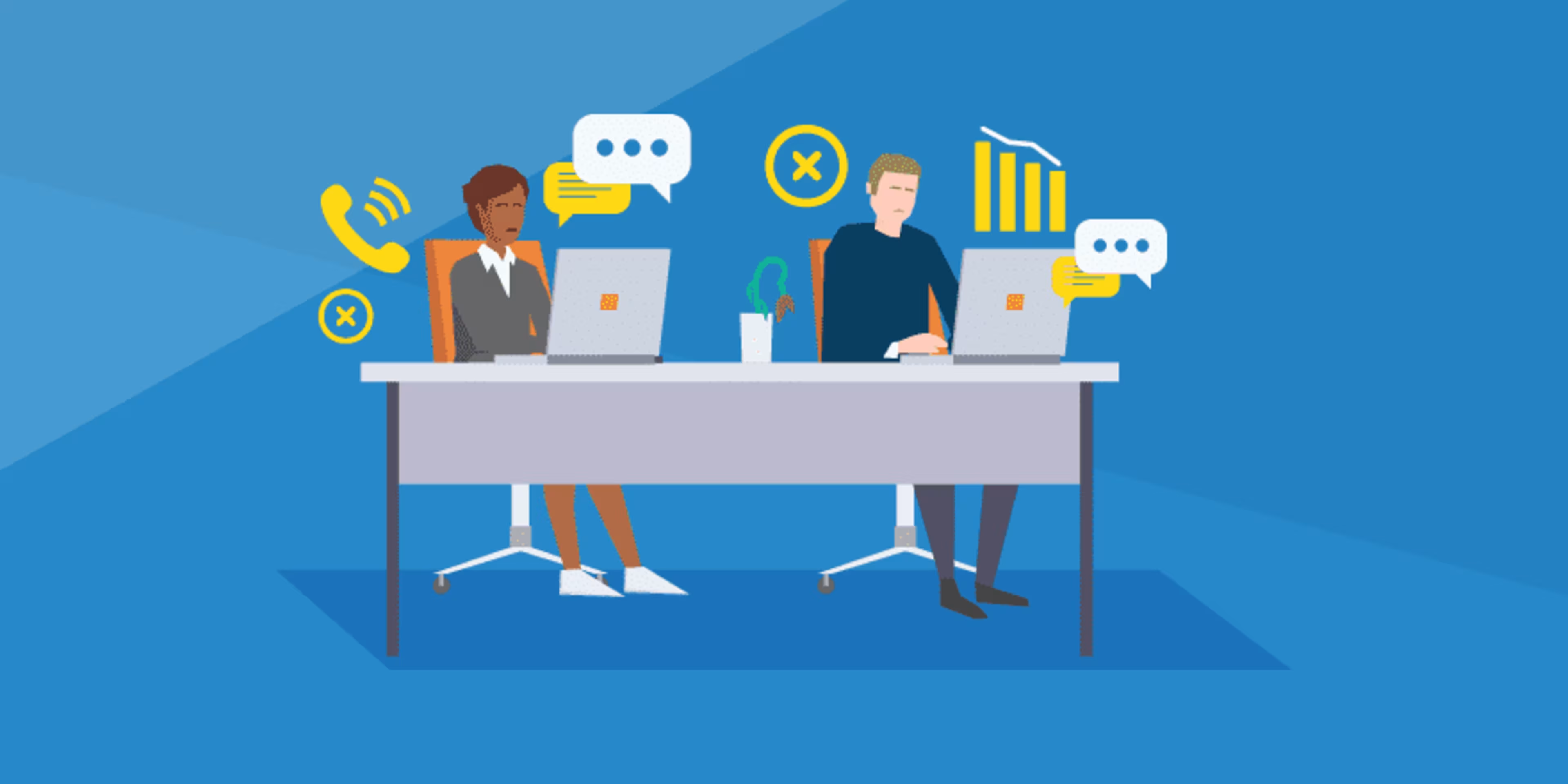
Thankfully, that's not a hypothetical question.
Three emerging office design initiatives—biophilic design, activity-based working, and smart workspaces—have already proved to offer the benefits that open offices never did.
It's imperative that HR, IT, and facilities managers collaborate on these office design initiatives now: Small businesses that invest in them will have a distinct advantage in attracting and retaining top talent moving forward.
With help from Gartner research, let's look at what these three initiatives entail and how you can implement them successfully in any current or future office space.
Biophilic design brings nature to the office
In a recent survey, more than 1,600 U.S. workers revealed the one office perk they value more than any other, and it isn't something elaborate such as a gym, a game room, or a fully staffed kitchen.
They simply want more natural light.
From sharp fluorescent ceiling bulbs to bright computer and smartphone screens, artificial lighting sources in the modern office have taken their toll on worker morale and wellness. In that same survey, 47% said they feel tired from the absence of natural light at their office; 43% said they feel downright gloomy from it.
If your office space suffers from a glut of artifice and enclosed spaces, it's affecting your employees more than you may realize. Which is why it's time you looked into implementing elements of biophilic design.
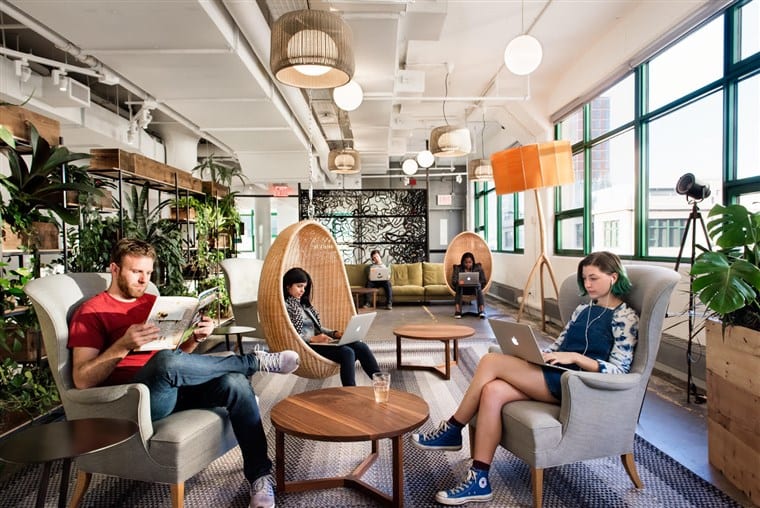
An example of biophilic design at Etsy's office in Brooklyn (Source)
Biophilic design integrates natural light, materials, and vegetation into work environments with the goal of not only providing aesthetic appeal but also having positive, therapeutic effects on workers. Picture multiple indoor planters, big windows, and a ton of wood furniture.
Amazon's Spheres at its Seattle headquarters are probably the most famous (and elaborate) example of this, but companies such as Etsy, Airbnb, and Microsoft have also hopped on the biophilic bandwagon.
You should too, as multiple studies show how beneficial biophilic office designs can be:
Offices optimized for illumination by sunlight report 51% fewer cases of eyestrain, 63% fewer cases of headaches, and a 56% reduction in drowsiness.
Employees who work among natural elements have 15% higher levels of well-being, 15% higher levels of creativity, and are 6% more productive overall.
Having plants in the office helps purify the air, which reduces the number of sick days that workers take.
While biophilic design may not address the specific layout challenges with open offices, it can provide significant advantages that every small business, regardless of layout, should consider.
3 tips for implementing biophilic design
Get employees involved. If workers want to bring in a plant or two for their desk, let them! Research shows workers who are permitted to include plants in their space are up to 32% more productive than workers without this option. They also identify more with their employer and demonstrate increased team commitment.
There are more options than wood and plants. Rock, sand, and water are also great biophilic elements that can add a much-needed natural accent to rooms dominated by colder materials such as marble or granite. Some businesses have even experimented with pumping in nature sounds to boost mood and productivity.
Invest in smart windows. Natural sunlight is great until it isn't, causing annoying screen glare and heating up the building. Unless you want to manually adjust blinds all day, consider investing in smart windows that automatically change their transparency based on how much sunlight there is. As an added bonus, you'll save on energy costs.
Activity-based working (ABW) leaves assigned desks behind
As employee demographics shift and technology becomes more capable, the when, where, and how of work has altered significantly.
Just look at some of these stats:
In 2016, 43% of U.S. employees spent at least some time working remotely. By 2020, that figure will jump to 50%.
The average decision-maker in a company today uses videoconferencing for nearly half of their total meetings.
59% of workers believe the traditional 9-to-5 workday is a thing of the past.
The result of all this change is that assigned desks have become archaic and incredibly expensive to maintain. More than half of businesses say they're getting rid of assigned desks in the next three years, primarily to reduce costs.
In its place, businesses have been experimenting with practices such hot desking (where workers take the first available desk) and desk hoteling (where workers reserve a desk online before they arrive). But these alternatives fail to address the primary objective with office space from a talent management perspective:
How do we make the best use of this space to get the most from each worker's efforts and interactions?
Redesigning workspaces with a concept called activity-based working (ABW) in mind solves this problem.
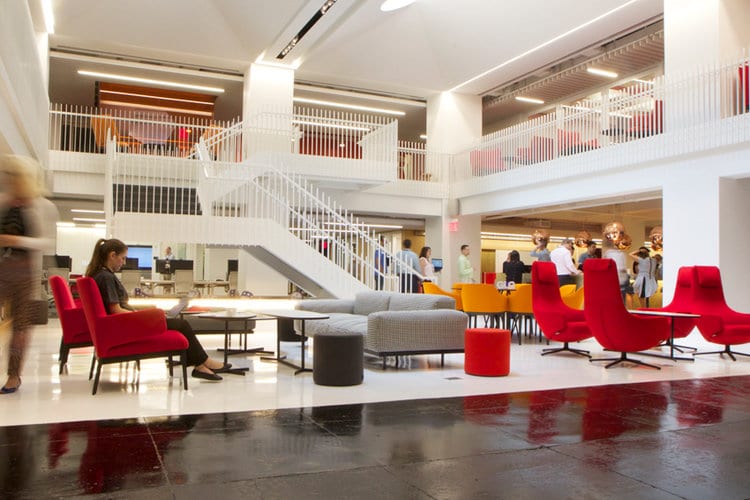
An example of an ABW-designed workspace in Gerson Lehrman Group's office (Source)
ABW goes deeper than the dichotomy between public spaces versus private spaces to provide a variety of flexible environments for specific types of activities. When a worker is doing a certain type of activity, they go to the space designed to support it.
For an example, let's turn to Gartner's “Create a Catalog of Activity-Based Spaces in the Digital Workplace to Improve the Employee Experience," which outlines six types of workspaces that might emerge when adopting an ABW mindset (full research available to Gartner clients):
6 types of ABW workspaces
Workspace | Description |
|---|---|
Town square | Town squares are public communal spaces that can be used for activities such as all-hands meetings or company celebrations. |
Neighborhood | Neighborhoods are designed for groups of people that need to come together for long periods of time to do similar, repeated activities. Your accounting department, for example, might work in a neighborhood. |
Workbench | Workbenches are meant for one-off collaborative projects with a definite end. Employees can stand up and break down workbenches as necessary to save space. |
Library | Libraries are smaller communal spaces where anyone can do ad-hoc, unstructured work such as reading, research, or coding. |
Alcove | Alcoves are quiet, personal spaces where people can recoup, reflect, and relax. Work shouldn't be done in an alcove. |
Fitness center | Fitness centers are spaces for communal exercise or wellness. Internally, this could be a group of walking desks or an area for meditation. Externally, this might be a path for walking meetings. |
ABW offices have been proven to cut costs, save space, increase collaboration, and improve team morale.
That's not all. According to Gartner's “Crafting Workspaces That Enhance the Employee Experience," organizations that support this kind of choose-your-own-workstyle culture will boost employee retention rates by more than 10% by 2020 (full research available to Gartner clients).
If you've been eagerly awaiting what comes next after open offices, it's ABW.
3 tips for implementing ABW
It starts with understanding your workers. Whether through a survey, or through informal interviews, it's important to develop an understanding of how your people prefer to work and how those preferences might be segmented into different ABW workspaces.
Beware of space overload. If you've identified seven ABW workspaces you want to implement, but your square footage can only accommodate five, that's a problem. Spaces fill up faster, employees then have to resort to their second or third choice, and the whole system breaks down. Keep expectations in check.
Don't neglect change management. The subconscious attachment to assigned desks won't disappear overnight. As much as 73% of your workforce won't work in the mobile or fluid way that ABW intends when you first implement it, but if you coach people and ensure management leads by example, this can help with the transition.
Smart workspaces leverage IoT to streamline chaotic work lives
Today's office is a hodgepodge of the physical and digital: supply closets and Slack channels, whiteboards and web conferences.
Up until this point, these two worlds really haven't intersected. But with the help of the internet of things (IoT)—which adds sensors and Wi-Fi capabilities to everyday objects such as desks and rooms to enable them to communicate information—smart workspaces are finally becoming a reality.
The physical and digital worlds meld to deliver new ways of working, sharing information, and collaborating.
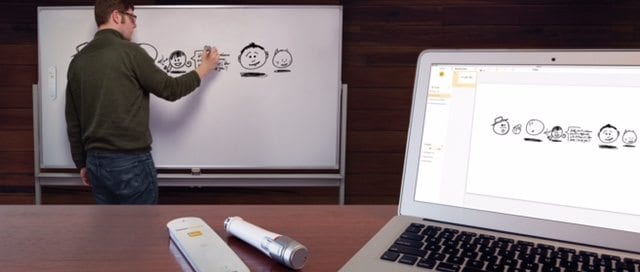
An example of a smart whiteboard powered by IoT (Source)
What does this look like in practice? Gartner's “Align Smart Workplace Efforts With Employee Needs for Knowledge-Based Work" offers a few examples (full research available to Gartner clients):
When you arrive at work, you get a notification from a virtual assistant on your phone with a recommendation of where to sit that day based on real-time availability, your personal preferences, and what's on your agenda.
When your manager moves a meeting to a conference room you're not familiar with, you pull up a map that not only shows all the room names but also where every employee is currently located in the building.
Before your meeting, attendees are automatically pinged to provide updates on their projects, which are then populated on digital signage in the meeting room. After the meeting, an audio/video recording and a written transcription of notes taken on a smart board are sent out to everyone.
As sci-fi as all of this may sound, our research shows that smart workspaces are going to be a reality at small businesses sooner than you may think.
According to a 2018 Capterra survey on top technology trends, 47% of U.S. small and midsize businesses (SMBs) are already using IoT, and another 15% plan to use it in the next one to two years.
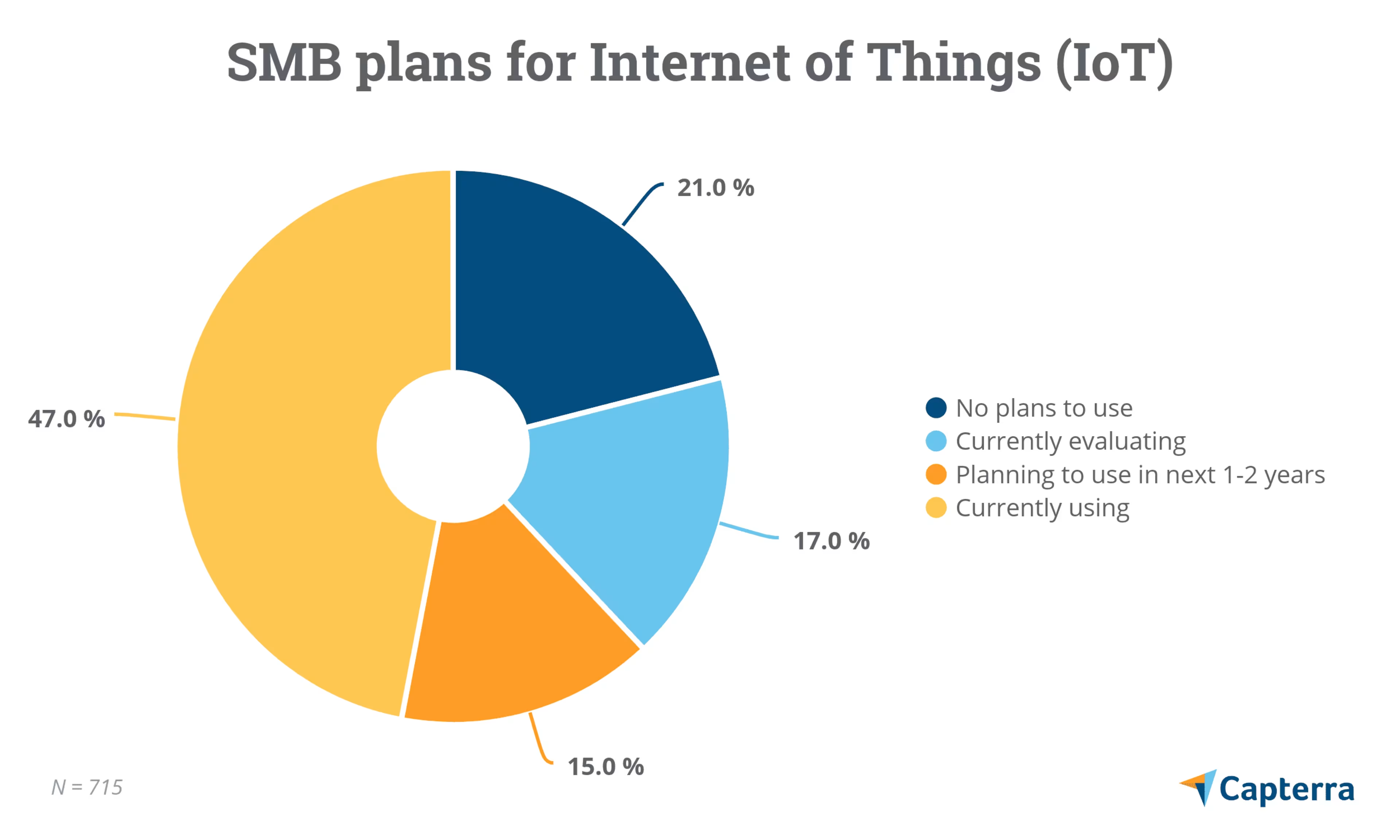
Gartner adds that, by 2020, 25% of organizations will have a catalog of smart workspaces at their disposal.
That's an exciting stat, but if you haven't started conceptualizing how smart workspaces will fit into your current office, you're already behind. Of the three design initiatives we've covered here, smart workspaces require the most time, money, planning, and brain power.
3 tips for implementing smart workspaces
Brainstorm fully defined use cases. Employee experience strategy dictates that businesses map out specific processes or “journeys" that workers encounter to identify areas for improvement. The same should be done with smart workspaces. Don't implement all of this cool tech without specific, measurable goals in mind.
Cement your software stack first. Before you run out and buy pallets of IoT sensors and smartwatches, you need to lock down the software systems you'll use to manage physical devices and communicate information. If you don't have a good collaboration tool or mobile device management system, get one.
Make your help desk more visible. The law of averages says that the more technology you implement in your workspace, the greater the chance that something will go wrong. Creating a Genius Bar-like help desk space gives your workers a greater employee experience when they need a fix for their smart workspace.
Start crafting the office you need to succeed today
Your office space isn't just four walls and a roof. It's a major component of the employee experience, and small businesses that don't treat it as such will see their best workers walk out the front door.
Whether it's something as simple as adding a few plants or something as complex as IoT, it's time to shake up the open office concept to start getting results.
If you want to learn more, check out “Gauge Your Workplace for Its Efficiency and Effectiveness Factor" to score your current workplace for its efficiency and effectiveness factor, then read “5 Myths About Workplace Effectiveness, Busted" to dispel more office inaccuracies.